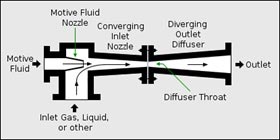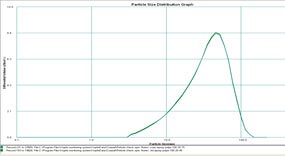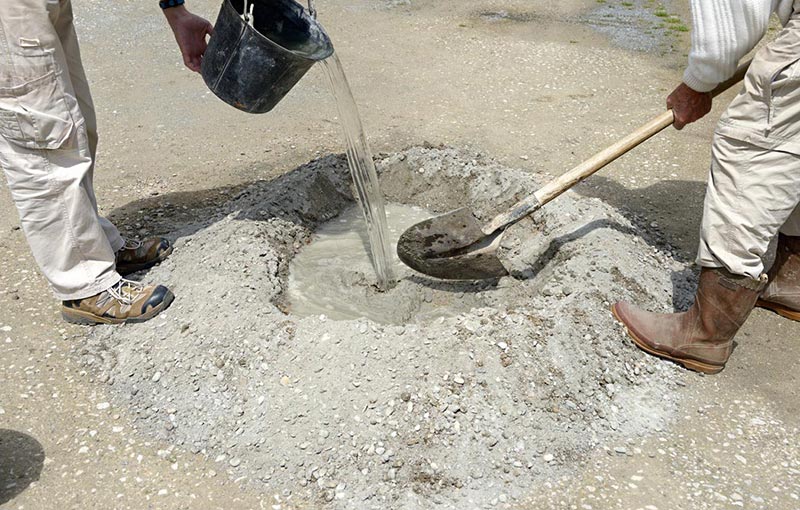What is the role of the eductor?
 Eductors are used in extracting sample from a lean phase flow and transporting the powder in a diluted form through a measurement cell. The Venturi effect (Bernoulli) is the principle of operation for this device. A converging-diverging nozzle converts the pressure energy of motive air (fluid) to velocity (Kinetic) energy which creates a low pressure zone (vacuum) which draws in sample from the process via the inlet. After passing through the throat of the injector the dust-laden gas stream expands and the velocity is reduced and passes through the measurement zone.
Eductors are used in extracting sample from a lean phase flow and transporting the powder in a diluted form through a measurement cell. The Venturi effect (Bernoulli) is the principle of operation for this device. A converging-diverging nozzle converts the pressure energy of motive air (fluid) to velocity (Kinetic) energy which creates a low pressure zone (vacuum) which draws in sample from the process via the inlet. After passing through the throat of the injector the dust-laden gas stream expands and the velocity is reduced and passes through the measurement zone.
This design is perfect for fine cohesive powders (the finer the better) but is not a panacea for every application. When a powder is transported into a standard eductor, the flow path takes it through a 90 degree bend which helps to disperse finer powders which need more impact energy to separate them into individual particles. This is important because although laser diffraction is an ensemble technique, we still need all the particles to be separate from each other.
The need for a coaxial eductor
 A co-axial eductor is different to the standard version in that the “Motive fluid” inlet and the “Inlet gas (aka “sample”) positions are transposed. The sample does not pass through a 90 degree bend but in a straight line with minimal impact of the particles. The co-axial eductors’ prime role is to transport the particles and keep them separated in as gently a way as possible. A classic example of the need to use a co-axial eductor.
A co-axial eductor is different to the standard version in that the “Motive fluid” inlet and the “Inlet gas (aka “sample”) positions are transposed. The sample does not pass through a 90 degree bend but in a straight line with minimal impact of the particles. The co-axial eductors’ prime role is to transport the particles and keep them separated in as gently a way as possible. A classic example of the need to use a co-axial eductor.
An epoxy dry powder coating has been measured with both the standard eductor and the co-axial eductor being tested sequentially on the same epoxy powder. The results over-plot each other thus proving that there is sufficient dispersal by the co-axial eductor. So we can use either eductor for this application, but the co-axial eductor has one key advantage over the standard eductor for this application. The glass transition temperature of many powdered coatings is very low, so much so that there can be a buildup of sample on the motive fluid nozzle which in time will eventually block up. With a co-axial eductor, the sample is travelling in the same direction as the dilution air which results in minimal contact with eductor wall or dispersion nozzle. The benefit is having a system which can work for long periods of time with the need for maintenance.
Examples of its usefulness in other key applications
 Another example indicating where the co-axial eductor is important, is in the production of alumina. Invariably there will be primary particles ranging from 30-130μ In addition to these primary particles, there are smaller secondary particles attached to their suface. When a co-axial eductor is used the finer particles are not stripped. Below we can see both results superimposed, with a longer tail of finer stripped particles being detected when the standard eductor is used. Where the key measurement parameters are %<20µ(for health, safety and environmental issues), %<45µ(10-12% maximum – to ensure lost production is minimised) it is important to only measure the primary particles.
Another example indicating where the co-axial eductor is important, is in the production of alumina. Invariably there will be primary particles ranging from 30-130μ In addition to these primary particles, there are smaller secondary particles attached to their suface. When a co-axial eductor is used the finer particles are not stripped. Below we can see both results superimposed, with a longer tail of finer stripped particles being detected when the standard eductor is used. Where the key measurement parameters are %<20µ(for health, safety and environmental issues), %<45µ(10-12% maximum – to ensure lost production is minimised) it is important to only measure the primary particles.
Other examples where a co-axial eductor should be used include the measurement of mica or kaolin which plate like particles, whose edges are easily abraided when a standard eductor is used. When a dry powder is measured either in the laboratory or on-line, either a flow rate or pressure titration is undertaken in order to determine the working flow or pressure range. This is not possible with a standard eductor titration of some fragile materials such as milk, sugar and coffee granules and many broad range samples in the pharmaceutical industry e.g. dispersion and measurement of paracetamol. In these applications only the co-axial eductor can provide the gentle dispersion which will allow you to determine an appropriate working flow range.
A perfect fusion of proven design and latest technology. Quite simply, the most compact, rugged, best performing in-process particle size analyzers at a fraction of the cost of competitors systems.











